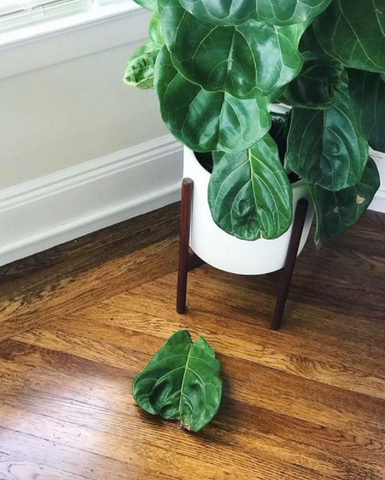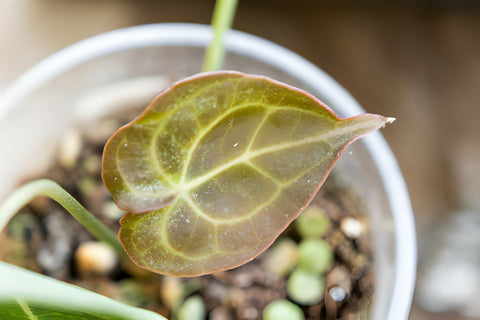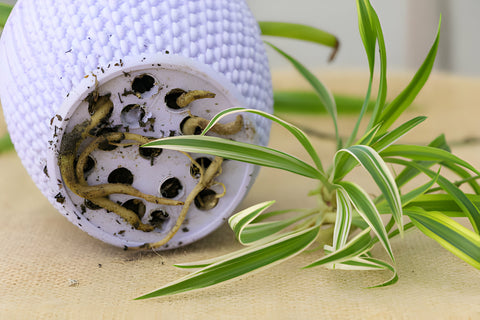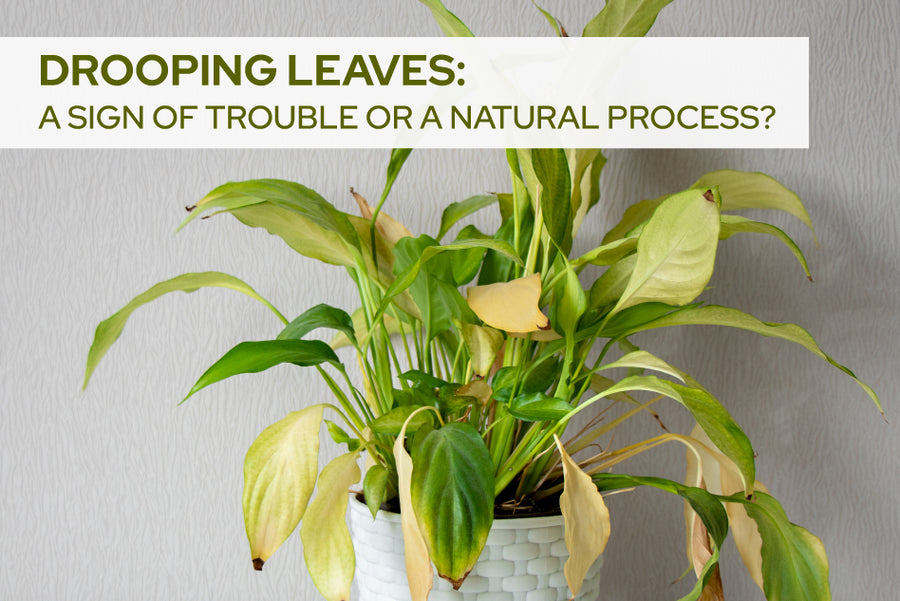You can always read your plant’s condition by looking at its leaves. Leaves are vital indicators of a plant's overall health and response to its environment. They are like your plants’ communication system. The reason is that leaves play a key role in photosynthesis, the process by which plants convert sunlight into energy. Any disruption in this process can affect the overall health of the plant, and changes in the leaves may indicate issues with light exposure or nutrient availability. By carefully observing the leaves, you can glean valuable information about the plant's well-being and make informed decisions on how to care for it. So, when those once lively, cheerful leaves start to droop and take on a bit of a somber appearance, you should start a thorough checkup for your plant.
For indoor gardening beginners, witnessing those sad, drooping leaves might seem a bit alarming at first. Is that a natural process or is your plant is sending out an SOS signal? It's perfectly normal to feel a bit concerned. However, the good news is that, more often than not, drooping leaves can be fixed once you figure out the reasons behind their distress. It's like solving a little mystery – once you identify the culprit, you're well on your way to bringing those leaves back to their happy, upright selves. So, don't fret too much, and let's dive into the detective work of understanding your plant's needs and restoring its vitality!
Drooping Leaves vs Wilting Leaves
Drooping leaves and wilting leaves are two different issues in houseplants. While both are signals of distress, they differ in appearance and potential causes. When a plant's leaves droop, they hang limply from the stem, conveying a sense of sadness.
Unlike wilting, drooping doesn't necessarily imply dryness or browning, and the overall health of the plant may remain robust.
On the other hand, wilting involves leaves becoming limp and shriveled, often due to factors like excessive heat and under-watering. Wilting leaves typically imply a more severe condition where the plant cells lose turgor pressure. Turgor pressure is the pressure of the cell contents against the cell wall, and it's what helps the plant maintain its rigidity. When a plant wilts, it's a sign that it's under significant stress, often due to insufficient water or extreme environmental conditions.
When we observe a drooping plant, it's important to note that despite the sagging leaves, the overall appearance of the plant often maintains a healthier look. Unlike wilting, where the entire plant might appear limp and in a state of decline, a drooping plant exhibits a more localized response. The rest of the plant, aside from the drooping leaves, typically retains its vibrancy and robustness.

Drooping leaves is different from wilting leaves.
Photo via Pinterest
Is Drooping Leaves A Natural Process?
Drooping leaves, although often a sign of stress or an issue, can also be a natural process for certain plants. Some plant species exhibit a daily rhythm of drooping and recovering as part of their natural growth cycle. This phenomenon is known as nyctinasty or sleep movement, where leaves adjust their position in response to light and darkness. Calathea plants are one example. They are called “Prayer Plants” because their leaves have a distinctive movement to respond to the change of daylight. The leaves close at night and open during the day. This rhythmic movement is part of the plant's natural behavior and is believed to be influenced by changes in light and the plant's circadian rhythm. The closing of the leaves in the evening is sometimes accompanied by a rustling or "praying" sound, hence the name.
In addition to daily movements, some plants may naturally droop their leaves during specific stages of their growth, like when they are transitioning from one growth phase to another. However, it's crucial to distinguish between these natural processes and drooping caused by environmental stress, inadequate care, or health issues.
It is also important to note that, plants can droop their leaves after being potted or repotted, as a sign of transplant shock. With a correct care routine and an ideal growing environment, the leaves will perk up and regain their vitality in a week or two.
Regular observation and understanding of the specific needs of your plant will help discern whether the drooping is a normal part of its behavior or a signal of an underlying problem.
Causes Of Drooping Leaves In Houseplants
Underwatering
Drooping leaves in houseplants can indeed be caused by underwatering. When a plant doesn't receive enough water, its cells lose turgor pressure, leading to wilting and a limp appearance of the leaves. The lack of water affects the plant's ability to maintain its structural integrity, resulting in drooping.
To address this issue, it's important to adjust your watering routine. Ensure that you provide an adequate amount of water to your plants, allowing the soil to be evenly moist but not waterlogged. Always check the moisture level in the soil before watering, as different plants have varying water requirements. Additionally, consider the environmental conditions, such as temperature and humidity, as they can influence the frequency of watering needed.
Overwatering
Overwatering is a common reason for drooping leaves in houseplants. When a plant is subjected to excessive watering, the soil can become waterlogged, creating an environment where the roots face oxygen deprivation. This oxygen shortage hinders the roots' capacity to efficiently absorb essential nutrients from the soil, resulting in a decline of turgor pressure within the plant cells. As a consequence, the leaves lose their rigidity and start to droop.
To address the issue of drooping leaves caused by overwatering, it's essential to reassess your watering practices. Allow the soil to dry out slightly between waterings to prevent waterlogged conditions. Ensure that the pots have proper drainage to facilitate excess water drainage and aeration for the roots. Adjust the frequency of watering based on the specific needs of each plant and the environmental conditions. By adopting a mindful watering approach, you can help your plants regain turgor pressure, reduce drooping, and promote overall health.
Pests
Drooping leaves in houseplants can also be a consequence of pest infestations. Certain pests, such as spider mites, aphids, or mealybugs, can suck out the sap from plant tissues, leading to a loss of moisture and turgor pressure. As a result, the affected leaves may appear limp and droopy. In addition to the drooping leaves, your plants may have other signs of pests like a white web-like substance, sticky sap on the leaves, or visible damage such as holes or discoloration. Additionally, you should also check the undersides of leaves for clusters of tiny eggs or the presence of pests themselves.
Once you identify signs of a pest infestation, it's important to take prompt action to address the issue. Depending on the type of pest, treatment methods may vary. For instance, spraying a neem oil solution can be effective against certain pests, while introducing natural predators like ladybugs can help control others. Regularly inspecting your plants and intervening at the early stages of pest infestations can prevent widespread damage and alleviate stress on the plants.

Pests is also one of the causes of drooping leaves on houseplants.
Photo via istockphoto
Lack Of Light
Insufficient light can indeed contribute to drooping leaves in houseplants. The process of photosynthesis, essential for a plant's vitality, heavily relies on an ample supply of light. When plants don't receive an adequate amount of light, their ability to carry out effective photosynthesis becomes compromised. As a consequence, the plant's structural integrity weakens, and this can manifest in the form of drooping leaves.
To address this issue, it's essential to understand the light requirements of your specific houseplants. Some plants thrive in bright, indirect light, while others may require more direct sunlight. Assess the lighting conditions in your home and ensure that your plants are placed in areas that align with their needs.
Consider rotating your plants periodically to expose all sides to light evenly, and if natural light is limited, supplement with artificial grow lights. By providing the right amount and type of light, you can support your plants in maintaining their structural integrity and prevent the occurrence of drooping leaves.
Root-bound
Root-bound can also be a reason for drooping leaves in your green companions. When a plant outgrows its container, the roots become crowded and entangled, restricting their ability to absorb water and nutrients effectively. This can result in a decline of turgor pressure in the plant cells, leading to the characteristic drooping appearance of the leaves. Moreover, as the roots struggle for space, they may become compacted, leading to poor aeration and drainage. This not only affects the plant's ability to absorb water and nutrients but also increases the risk of root rot and other soil-borne diseases, resulting in drooping leaves.
To prevent and address root-bound issues, it's crucial to observe the growth patterns of your houseplants and monitor their root health. Aside from drooping leaves, check for signs of a root-bound including visible roots emerging from drainage holes, stunted growth, difficulty watering, a pot-bound appearance, wilting despite adequate watering, protruding soil, and yellowing leaves. If you notice these indicators, consider repotting your plant into a larger container to ensure proper root development and overall plant health. When repotting, gently tease out the roots to encourage them to spread in the new soil. Providing adequate space for the roots to grow freely promotes a healthier root system and reduces the risk of drooping leaves.

Repotting houseplant when it's root-bound can prevent leaves drop.
Photo by Gheorhge
Lack of Nutrients or Overfertilization
Drooping leaves in houseplants can be attributed to issues related to nutrient availability, either from a lack of essential nutrients or overfertilization. When a plant lacks crucial nutrients, it may struggle to maintain turgor pressure in its cells, leading to a drooping appearance. On the other hand, overfertilization can cause imbalances in nutrient uptake, affecting the plant's overall health and causing the leaves to droop.
To address this, adopt a careful and well-informed fertilization routine, taking into account the specific requirements of your plant species. Regularly assess your plants for signs of nutrient-related issues, such as changes in leaf color or texture, and adjust your fertilization practices accordingly. This proactive approach will contribute to the overall well-being of your houseplants and help prevent the occurrence of drooping leaves.
How To Revive Houseplants With Drooping Leaves
To revive your houseplant, first, you need to identify the cause and adjust your care routine accordingly. Begin by examining factors such as watering, light exposure, and potential root-bound conditions. Once the cause is identified, make necessary adjustments, such as correcting watering practices or providing more light. Trim away any damaged or dead leaves to encourage new growth. It's crucial to be patient during this process, as plants may take time to recover. Give your plant the care it needs, and with time and consistent attention, you can nurture it back to health, witnessing the return of vibrant and upright leaves.
When dealing with a pest infestation on your plant, it's crucial to prune off dead or damaged leaves. Removing affected parts can improve the plant's aesthetic appeal and help your plants to recover. Pruning encourages the plant to allocate energy towards new, healthy growth, aiding in its overall revitalization. Utilize clean, sharp pruning tools to minimize stress on the plant during this process. Alongside pruning, continue to address the root cause of the pest issue, whether through natural remedies or appropriate pest control measures, to ensure a sustained recovery for your houseplant.
The most important part of nursing a droopy houseplant back to health is creating a supportive environment. Ensure optimal humidity levels and avoid extreme temperature fluctuations, as these factors play a crucial role in a plant's well-being. Consistent humidity helps the plant regulate water intake and minimizes stress, contributing to the revival of drooping leaves. Additionally, stable temperatures prevent shock and further distress, allowing the plant to focus on regaining its vitality. Adjust the watering schedule and provide your plants with plenty of indirect bright light and good airflow.
Additionally, if your plant shows signs of being root-bound or the soil appears depleted, consider repotting. Choose a slightly larger pot with well-draining soil to provide the plant with fresh nutrients and room for healthy root development. If your plant has signs of nutrient deficiency, provide it with a balanced, diluted fertilizer solution. This will help replenish essential nutrients and support the plant's recovery. Be cautious not to over-fertilize, as this can lead to other issues.
































































































